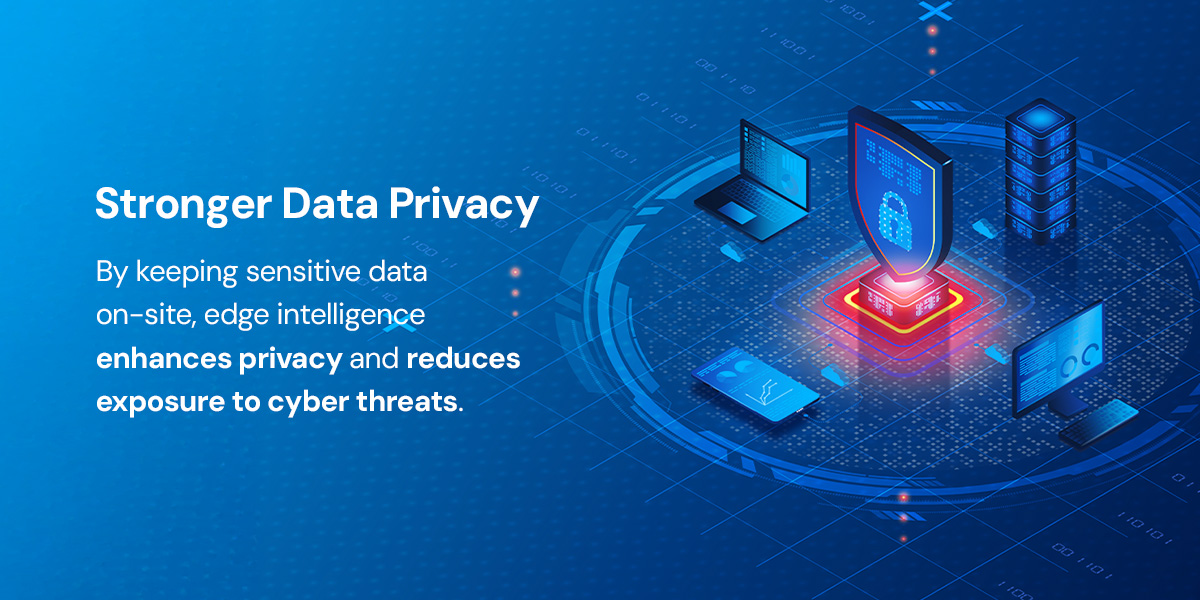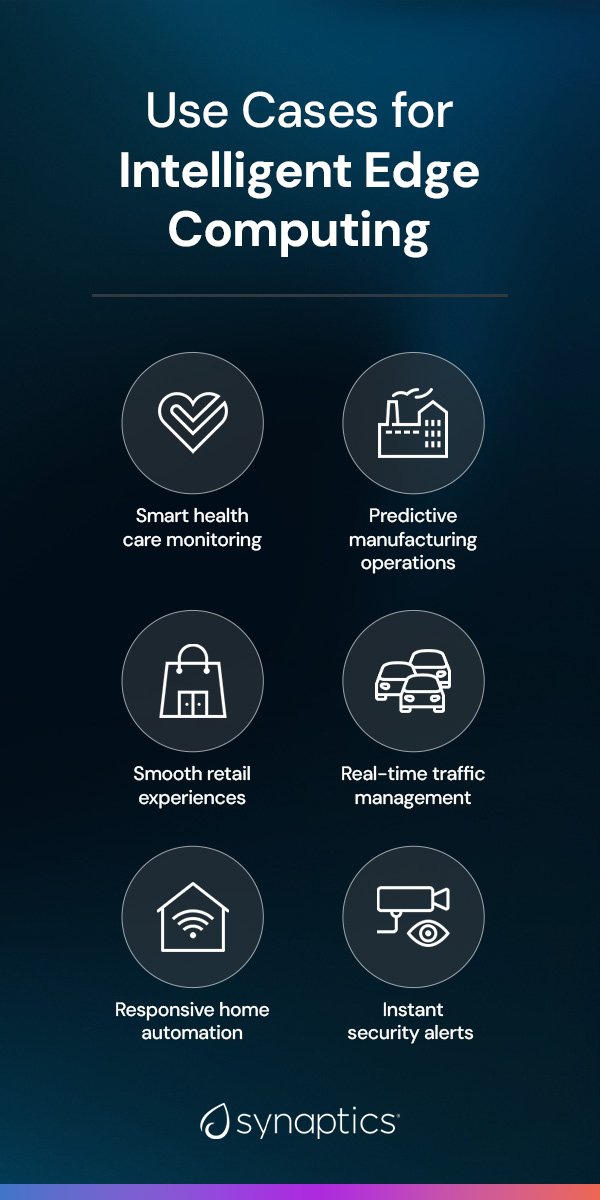The rise of edge technology is transforming how data is processed and decisions are made, right where data is generated. Unlike traditional cloud computing, intelligent edge computing pushes processing closer to the source, enabling faster responses and improved efficiency. The global edge AI market reflects this shift, which was valued at $20.78 billion in 2024. By 2030, it's projected to grow at a compound annual growth rate of 21.7%.
As industries like manufacturing and health care harness real-time insights, devices with intelligent edge capabilities, also known as edge intelligence capabilities, are becoming essential to modern operations.
This approach is no longer a futuristic concept, but a key driver for operational improvement. The average manufacturing company adopting edge technology realizes a 28% decrease in operational expenditures compared to deploying traditional cloud-based solutions. In health care, edge technology has the potential to help eliminate barriers to care and improve care accessibility by enabling remote monitoring and digital service delivery.
Our guide provides an in-depth understanding of edge technology, including its role in artificial intelligence (AI), key benefits, and relevance to operational and information technology. We'll also explore real-world use cases and applications in the Internet of Things (IoT).
What Is Intelligent Edge?
Edge intelligence is the ability to process and compute data closer to where it’s generated, which is at the edge of a network. Moving computation closer to data sources like IoT devices with sensors reduces latency, minimizes bandwidth and enhances security. This leads to faster decision-making and more responsive operations.
IoT edge currently dominates the landscape, but edge solutions are quickly gaining traction across operational technology and information technology as well.Instead of sending data back and forth to the cloud, edge technology uses modern IT infrastructure to deliver actionable insights in real time. As more devices and systems generate data, edge technology becomes critical for turning that data into measurable outcomes. It enables businesses across industries — from telecommunications and manufacturing to public infrastructure — to optimize performance, streamline processes and improve user experiences.
The Role of AI in Intelligent Edge Computing
Artificial intelligence is central to transforming edge computing into a more responsive, efficient and autonomous system. While cloud AI processes data on remote servers, which is suitable for heavy workloads, it often suffers from latency, bandwidth limitations and privacy concerns.
Edge AI executes machine learning tasks directly on local devices, enabling faster decision-making through real-time analytics without relying on constant connectivity. This functionality is critical in time-sensitive applications such as autonomous health care monitoring, retail and customer service, industrial automation and the energy sector.
Intelligent edge computing uses localized AI capability to deliver rapid insights, boost security and personalize user experiences right where data is generated. It allows systems to function independently, even in low-connectivity environments, by analyzing and acting on data at the source. This edge-based approach lowers data transmission costs and enhances data privacy by keeping sensitive information on the device.
Unlike cloud-dependent systems, edge AI can respond instantly even during network disruptions, which is ideal for mission-critical scenarios. From edge AI smart home devices to connected infrastructure in smart cities, intelligent edge solutions are reshaping how industries operate.
Intelligent Edge Computing Benefits
Below are several key advantages of using edge AI technology:
1. Lower Bandwidth Demand
Handling data locally reduces the volume sent to the cloud, easing pressure on networks and cutting data transfer costs. This is especially useful for IoT-heavy environments where continuous streaming would otherwise overwhelm systems.
2. Faster Decision-Making
Processing data closer to its source minimizes lag, enabling real-time responses in critical environments. This speed is important for applications like smart manufacturing, health care systems, public infrastructure, telecommunications and logistics.
3. Reduced Operational Costs
By offloading workloads from centralized resources, businesses save on cloud computing fees, power consumption and infrastructure costs. Edge intelligence also minimizes the need for constant monitoring from data scientists.
Fewer data transfers mean less reliance on expensive high-bandwidth internet connections. Over time, these savings contribute to a more sustainable and cost-efficient IT system.
4. Stronger Data Privacy

By keeping sensitive data on-site, edge intelligence enhances privacy and reduces exposure to cyber threats. This approach is ideal for industries with strict data compliance requirements, such as finance and health care.
It also limits the risk of data interception during transmission to centralized systems. With local data governance, organizations gain more control over how and when data is accessed or shared.
5. Real-Time Insights and Analysis
Edge devices analyze data on the spot, allowing organizations to act instantly on trends, anomalies and equipment status without waiting for cloud processing. This enhances decision-making in fast-paced and high-risk environments.
It also allows localized machine learning models to evolve based on current conditions. The result is smarter operations with faster feedback loops and improved outcomes.
6. Greater Reliability and Uptime
One of the biggest advantages of intelligent edge technology is its reliability. Because data is processed right where it's created, users experience fewer service interruptions. This decentralized approach ensures that even if the central servers fail or the internet connection drops, local operations continue to function smoothly.
Intelligent edge technology also allows for predictive maintenance and timely troubleshooting, reducing the likelihood of extended downtime.
7. Enhanced Workplace Safety
Deploying sensors at the edge enables real-time monitoring of environmental hazards and equipment status, improving response times and reducing risks in dangerous and remote jobsites. This proactive approach helps to prevent accidents.
In industries like mining and construction, edge technology supports compliance with strict safety regulations. It also enables automated alerts for predictive maintenance, reducing the occurrence of equipment malfunctions.
8. Flexible and Scalable Architecture
Edge-based systems adapt more easily to changing workloads. Businesses scale incrementally without overhauling infrastructure, especially with modern original equipment manufacturer (OEM) devices now integrating native edge features. This modular approach enables faster deployment of new services and capabilities. It also supports hybrid environments, where edge and cloud resources can seamlessly work together. From retail to energy industries, edge technology can integrate with existing systems, offering a future-ready solution that evolves with business needs.
Intelligent Edge in Operational and Information Technology
Operational technology (OT) refers to the hardware and software systems that monitor and control physical devices, typically in industrial environments like manufacturing, utilities, transportation and logistics. Information technology (IT) encompasses computing systems, networking, storage and infrastructure used to process, manage and share data, including IoT technologies. While OT historically operated in isolation, advances in IT have driven a significant convergence between the two.
A key driver of OT and IT convergence is the IoT, which enables devices to collect, transmit and process data across networks. Traditional OT systems lacked networking capabilities and required manual oversight. By integrating IoT and intelligent edge computing, organizations transform static OT environments into dynamic, data-driven systems. This allows data to be processed locally, near the device, rather than in a centralized cloud for faster insights and decision-making.
For example, imagine a factory sensor collecting data on a machine. Instead of simply recording the data, it now transmits it wirelessly to an IoT hub or gateway. This gateway then transfers the information to an analytics application, integrating it into the organization's unified system of business operations.
Additionally, adding intelligent edge computing capabilities to IoT devices enables timely data processing closer to the source. Instead of sending data to a centralized location, IoT devices analyze time-sensitive manufacturing data on-site, offering immediate insights for direct monitoring of working conditions. This is important in distributed network architectures where transmission to a central processing location is limited or impossible. It’s also useful for systems that require immediate action, such as maintenance repairs, ensuring devices operate reliably to avoid downtime.
For example, imagine a factory sensor collecting data on a machine. Instead of simply recording the data, it now transmits it wirelessly to an IoT hub or gateway. This gateway then transfers the information to an analytics application, integrating it into the organization's unified system of business operations.
Additionally, adding intelligent edge computing capabilities to IoT devices enables timely data processing closer to the source. Instead of sending data to a centralized location, IoT devices analyze time-sensitive manufacturing data on-site, offering immediate insights for direct monitoring of working conditions. This is important in distributed network architectures where transmission to a central processing location is limited or impossible. It’s also useful for systems that require immediate action, such as maintenance repairs, ensuring devices operate reliably to avoid downtime.
Use Cases for Intelligent Edge Computing

To illustrate the power and versatility of edge computing, let's explore these real-world intelligent edge examples:
- Smart health care monitoring: Edge-enabled medical devices and patient wearables now allow real-time analysis of patient vitals like heart rate, glucose levels and respiration. This localized data processing ensures timelier response times, enhances privacy and enables proactive care that's essential during emergencies. Immediate insights can also significantly support paramedic and hospital staff decisions.
- Predictive manufacturing operations: Manufacturers are integrating intelligent edge computing to predict equipment issues. By analyzing sensor data on factory-floor IoT devices, companies perform timely repairs, prevent costly downtime and improve worker safety without relying on cloud latency.
- Smooth retail experiences: In physical stores, edge AI powers personalized shopping with smart carts, real-time inventory management and cashier-free checkout. These innovations help retailers stay competitive by enhancing in-store convenience and gathering physical store insights into customer behavior.
- Real-time traffic management: Smart cities rely on edge AI to optimize traffic flow, reduce congestion and respond to incidents immediately. A powerful intelligent edge example is using AI-equipped traffic cameras to dynamically adjust traffic signals based on current vehicle density and movement.
- Responsive home automation: Smart home devices, from doorbell cameras to lighting systems, use edge AI to analyze data locally, delivering instant responses and better privacy protection. These smart home systems recognize faces, adjust environmental controls and detect inconsistencies without needing to send data to the cloud.
- Instant security alerts: Surveillance systems with edge processing capabilities now detect and respond to suspicious activities on-site. They analyze video feeds in real time, while smart cameras trigger alerts and actions faster than traditional cloud-based systems. This helps enhance home and office security, giving peace of mind.
Intelligent Edge Technology in IoT Devices
IoT devices are evolving rapidly, gaining the ability to process data where it’s generated rather than relying solely on the cloud. This shift is powered by edge computing, enabling real-time insights, minimized latency and smarter decision-making at the source.
Here are key applications for IoT-enabled edge technology in various industries:
1. Industrial and Manufacturing
IoT-enabled intelligent edge devices on the factory floor instantly analyze performance data, detect anomalies and trigger maintenance alerts before issues escalate. This reduces downtime and improves overall productivity by ensuring that machinery stays in optimal condition. Additionally, intelligent robotics on production lines enables real-time adjustments based on sensor data. These edge-enabled robots streamline operations, increase throughput and improve efficiency.
Processing data locally allows manufacturers to respond rapidly to changing demands, ensuring greater flexibility and faster decision-making. By eliminating the need to send large amounts of data to the cloud for analysis, edge computing ensures that manufacturing processes remain agile and responsive.
2. Smart Cities and Public Infrastructure
IoT-enabled edge devices are vital in smart cities, enabling live traffic monitoring, optimizing traffic flow and improving public safety with video analytics. These devices analyze data on-site, making it possible to adjust traffic lights or manage incidents more efficiently, leading to smoother commutes and enhanced public safety.
Intelligent edge devices with IoT support environmental monitoring systems that track air quality, noise pollution and waste management. Processing data locally enables faster, more accurate decisions that can help maintain a cleaner, healthier urban environment. Edge computing also powers energy optimization in smart grids by adjusting power distribution based on the latest consumption data. This promotes efficient use of resources and less energy waste, integrating renewable energy sources into the grid to support sustainability goals.
3. Health Care

Intelligent edge devices support remote patient monitoring and telemedicine. Wearable devices track patients' vital signs, sending alerts when abnormalities are detected. The ability to process this data locally allows health care providers to respond instantly to emergencies, improving patient outcomes and reducing hospital visits.
IoT-enabled intelligent edge devices also enhance telemedicine by supporting high-quality video consultations and providing immediate access to patient records, even in remote areas with limited connectivity. This empowers health care professionals to diagnose and treat patients properly, improving access to health care services in underserved regions.
4. Retail and Customer Service
Edge-enabled devices with IoT help optimize inventory management and enhance the customer experience. Smart shelves equipped with sensors track inventory levels in real time, automatically notifying staff when products are running low and prompting restocking processes. This minimizes out-of-stock situations, ensuring that customers always find what they need.
In micro-fulfillment centers, IoT-enabled devices track stock levels, predict demand and automate replenishment tasks. This ensures faster deliveries and minimizes the risk of overstocking or stockouts. Edge-enabled IoT devices can also personalize in-store experiences by analyzing customer behavior and preferences. For example, interactive screens can provide tailored product recommendations based on live analysis of customer interactions, enhancing the shopping experience and driving sales.
5. Agriculture
Intelligent edge devices with IoT, such as soil sensors, weather monitors and field-based actuators, are driving modern farming. These tools collect data directly from the environment and analyze it locally to guide farming decisions, such as adjusting irrigation levels and detecting pest activity.
By monitoring soil health, moisture and climate patterns, IoT-enabled edge devices help farmers optimize water and fertilizer usage, reduce waste and increase crop yields. Local processing ensures fast responses to changing conditions without depending on remote servers.
Explore Intelligent Edge Design Solutions With Synaptics
Intelligent edge is revolutionizing how IoT devices interact with the world, enabling real-time decision-making and enhancing digital experiences. Synaptics empowers this transformation with the latest edge design solutions, such as the Synaptics Astra™ AI-native embedded compute, delivering efficient AI-powered processing directly to the device edge. We provide applications that fit your needs, from smart appliances and home automation to manufacturing and industrial systems. You can also choose highly customized compute solutions for operator and unified communication and collaboration markets.
Synaptics is at the forefront of edge AI innovation, creating solutions that redefine how we interact with connected devices across all environments. Trusted by leading global innovators, Synaptics' advanced sensing and connectivity technologies are driving the next generation of digital experiences, making them faster, smarter, more secure and seamlessly intuitive.
Ready to unlock the full potential of edge technology? Contact us online today to explore intelligent edge design solutions and learn how Synaptics can help transform your business.


